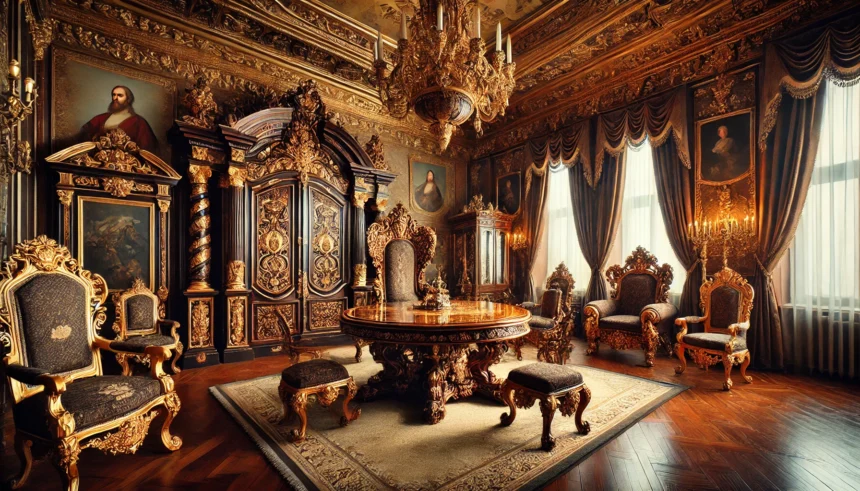If my followers are all about the history and luxury of fine furniture design, then wait no longer: “Catherine, the Great Furniture” is where you probably go to familiarize yourself with opulence or grandeur in historical designs. The Empress of Russia, Catherine the Great, was an internationally acclaimed monarch due to her taste in arts and furniture. She inspired and infected more than politics; elegance spread to the very homes of the aristocracy – her unusual style became a badge of sophistication. Breaking Down Catherine the Great FurnitureIn this article, we’re diving into the intriguing world of furniture inspired by Catherine The Nice to provide you with a brief view of her history about what features make it so special and how long-lasting its impact on modern design remains. This trip down memory lane will mesmerize any history buff or interior design lover.
Historical Background
Catherine the Great (1729 – 1796) was Empress of Russia from 1762 until her death, and in many respects, she remained foreign to Russians till December that day at Winder Palace. During her reign, there were radical changes in culture and politics, making her one of the most important figures in world history. A patron of the arts and a great collector, she commissioned prestigious artists and artisans throughout Europe. Her passion for art and design greatly impacted the rest of Russian culture, which also affected how furniture was produced.
The Era of Enlightenment
The Enlightenment was in full swing during her Tudor reign, contributing to a revival of intellectual and cultural life that still rages today. Catherine took to these ideas, drawing on them to develop a more refined arts and knowledge society. It was during this time that great palaces were erected and their interiors lavishly furnished, to a degree sympathetic with the taste of the Empress but also influenced by Enlightenment conceptions of beauty and reason.
European Style Influence
Catherine the Great’s chairs shared much in common with European samples from France and England. She fell in love with Rococo and Neoclassical styles, known for their elaborate detail work, gentle curves, and sense of the grand. Catherine added to the mix her sensibilities, merging these elements with Russian motifs that were both unique and luxurious—representing her legacy CrossRef ExternallyDescribed, which had spread across Europe.
What Makes Catherine the Great Furniture Special?
Catherine the Great Furniture‘s reputation benefits from its master craftsmanship, high-quality materials, and signature design features. Some important elements embody this style, so let’s examine them.
Luxurious Materials
Catherine the Great loved luxury, as evidenced by her use of materials in her furniture. Exotic veneers and detailed marquetry often created richly finished surfaces of inlaid mahogany or walnut. Precious metal, semi-precious stones, and gilded accents heightened the luxurious feel.
Intricate Carvings
Intricate carving work is one of the hallmarks of Catherine the Great’s furniture. Their skilled artisans made intricate designs with floral fancy mythology and geometric patterns. These carvings gave each piece character and texture, defining the furniture as artistry displays.
Elegant Silhouettes
The furniture designed under Catherine the Great usually far-removed of elegant, graceful silhouettes. Softly curved lines characterized chairs and sofas, while tables and cabinets offered well-moderated proportions. This focus on shape and symmetry gave a sense of order and elegance to everything.
Neoclassical Elements
Neoclassicism, influenced particularly by neoclassical design based on ancient Greek and Roman art and architecture, was one of the leading influences on Catherine: The Great Furniture. This type is known for its simplicity in its lines, symmetry of shapes, and classical embellishments like columns, laurel wreaths, or urns. Those elements gave the furniture an air of timelessness and grandeur.
Influence on Modern Design
Catherine the Great’s furniture is considered a classic, but this influence goes beyond her statute. Her approach determined many future designs. Catherine’s style inspires modern designers today, as seen in the detailing and craftsmanship that brought about the golden era.
Revival of Classic Styles
Classic styles always intrigue those working in the field, and Catherine The Great is no different when it comes to interior design. Many contemporary furniture designers go back to the much-loved Neoclassical and Rococo elements of her haptic audio throughout, giving us a glimpse of how her fans express creativity in reinterpreting these Levantine standards. This rejuvenation adds a classic sophistication to modern spaces.
High-grade construction materials and design
The focus on the best materials and exceptional work exhibited by Catherine the Great Furniture serves to this day as a model for contemporary designers. Yet catfishing is once more becoming a valued skill as the modern age embraces artisanal craftsmanship and bespoke products reminiscent of Catherine’s time.
Mixing Old and New
Contemporary interior trends often combine antique and modern design elements. Antique or reproduction furniture gives contemporary spaces historicity and flavour. In an achingly hip interior such as this, Catherine the Great furniture—irreproachably heritage-rich and with a Noteboom-design sensibility all its own—feels absurdly right.
Catherine the Great Furniture Collection
Consequently, acquiring genuine Catherine the Great furniture can be very rewarding for collectors and enthusiasts. But it takes taste, effort and attention to detail. Tips for those wanting to start a collection
Research and Authentication
Proper research is key before you buy a piece. Knowing the history, design features, and usual materials used for Catherine-type furniture will help you recognize it. Seeking expert advice and obtaining approvals from reliable sources can also avoid expensive blunders.
Condition and Restoration
The value of antique furniture is greatly determined by its condition. Although a bit of wear and tear is to be expected, excessive harm can significantly decrease the value of any piece. When looking at restoration, the key is to find that balance between keeping it original and making it look nice while still being functional, so let’s begin.
Provenance and Documentation
Provenance is the history of ownership, which adds value and authenticity. Highly coveted are pieces with provenance or which can be shown to have been part of well-known, otherwise untraceable furniture collections. It is necessary to keep records and document your acquisitions for future use.
Where to Buy
You can acquire original Catherine the Great furniture in different ways, such as auctions, antique stores, or specialized galleries. Online platforms have also soared in popularity, but buyers should carefully check the sellers’ legitimacy.
FAQs
Q1. Which Ones Of Catherine the Great Furniture Were Used?
When it comes to Catherine the Great’s furniture, rich woods, such as mahogany and walnut, are often heavily featured, with gilded accents using precious metals like gold or silver/copper leafing combined with semi-precious gemstones.
Q2. What Defines Genuine Catherine the Great Furniture?
Know the history, designs and period-appropriate materials of genuine items. It should also be authenticated with the advice of experts.
Q3. In Which Styles Were Catherine the Great Furniture Created?
Catherine the Great’s furniture was influenced by Neoclassical and Rococo styles. It features clean lines, classical motifs, like Greek keys fluting or rosettes, and elaborate ornamentation.
Q4. Catherine, the great furniture still current trends?
Indeed, its ever-timeless elegance and craftsmanship still inspire contemporary makers and collectors.
Q5. Where to Shop for Genuine Catherine the Great Furniture
Genuine antiques are available at auctions, antique dealers, specialized galleries and online platforms. While verifying the authenticity with the seller and obtaining appropriate authentication.
Conclusion
Not only does Catherine the Great’s furniture offer a collection of beautiful things, but it also embodies elegance and craftsmanship that has become a cultural heritage. This style remains omnipresent and alluring, from the luxury materials and intricate designs to its still-felt influence on contemporary interiors. For collectors: If you are a collector or are interested in history and design elements, consider discovering the world of Catherine II furniture as it is attached to opulence-era sophistication.










